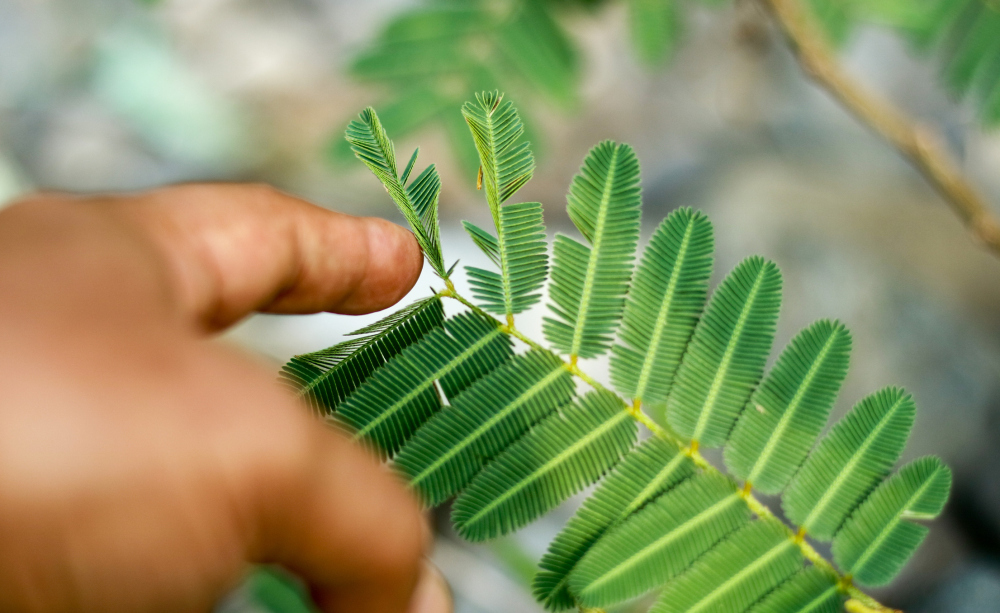
The Sensitive Plant, or Mimosa pudica, is one of nature’s most entertaining houseplants. Known for its unique ability to move in response to touch, this fascinating plant folds up its delicate leaves when brushed, poked, or shaken—a defense mechanism evolved to startle herbivores. Within minutes, the leaves reopen, as if nothing happened.
Native to South and Central America, Mimosa pudica is a fast-growing, low-sprawling plant that produces soft, fern-like foliage and fluffy pink or lavender puffball flowers during warm months. While often grown as a novelty or conversation starter, the Sensitive Plant also makes a great addition to sunny windowsills, kids' gardens, or plant collections with a quirky twist.
Bright light is a must. Mimosa pudica thrives in full sun or bright, indirect light indoors. The more light it gets, the healthier and more responsive it will be. Outdoors, place it in a sunny spot, and indoors, give it a south- or west-facing window.
Insufficient light can lead to leggy stems and sluggish leaf movement.
Mimosa pudica prefers consistently moist soil, but not soggy. Water when the top inch of soil feels dry, and ensure excess water can drain freely. It’s sensitive to both overwatering and underwatering—too much can cause root rot, while too little may cause drooping or leaf loss.
Keep the watering routine steady, especially during hot months when the plant grows quickly.
Plant in light, well-draining soil—a standard indoor potting mix works well. For best results, choose a pot with good drainage holes to avoid waterlogging.
If growing in a container, repot annually or as needed to refresh the soil and allow space for its spreading roots.
The Sensitive Plant loves warmth. It prefers temperatures between 65–85°F (18–29°C) and should be protected from drafts and cold. Mimosa pudica is not frost-tolerant and will die back in chilly conditions.
In cooler climates, grow it indoors year-round or treat it as a summer annual.
Mimosa pudica appreciates moderate to high humidity, especially indoors during winter when air tends to be dry. You can increase humidity by misting occasionally, grouping it with other plants, or using a small humidifier nearby.
Feed every 4–6 weeks during the growing season (spring to early fall) with a diluted balanced liquid fertilizer. Avoid overfeeding, which can lead to weak growth or salt buildup in the soil.
You can pinch back the stems on your plant to encourage bushier growth and keep it compact. Prune off any dead or yellowing leaves to maintain its appearance.
Be gentle! Rough handling may stress the plant and cause excessive leaf drop.
In ideal conditions, Mimosa pudica produces tiny pink or lavender pom-pom flowers in summer. They’re not long-lasting, but they add a sweet, whimsical touch to the already curious plant.
Sensitive Plants can be easily grown from seeds, which germinate quickly in warm, moist soil. Sow seeds indoors 4–6 weeks before the last frost, or directly into the garden after frost danger has passed. Soaking seeds for a few hours before planting can speed up germination.
Cuttings can be tricky—seeds are the most reliable propagation method.
Mimosa pudica is considered mildly toxic to pets. While not deadly, ingestion may cause digestive upset. The plant also has tiny thorns along its stems, so keep it out of reach of curious pets and small children.
The Sensitive Plant is part of a small group of plants that exhibit thigmonasty—a rapid movement in response to touch or vibration. The mechanism is triggered by electrical signals and changes in water pressure within the leaf cells, making it one of the coolest science experiments in your windowsill.